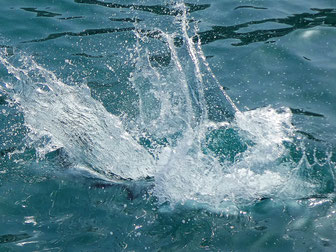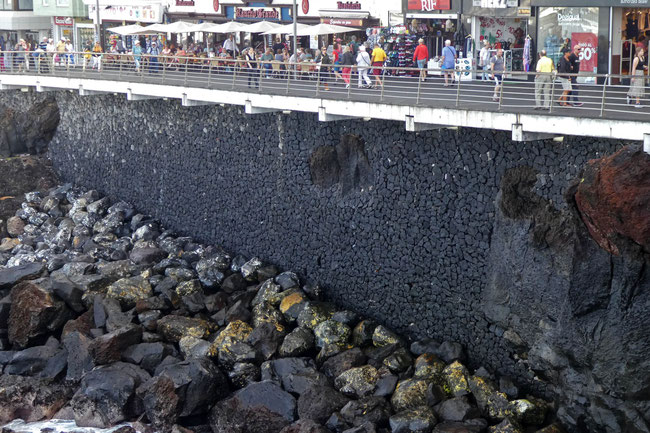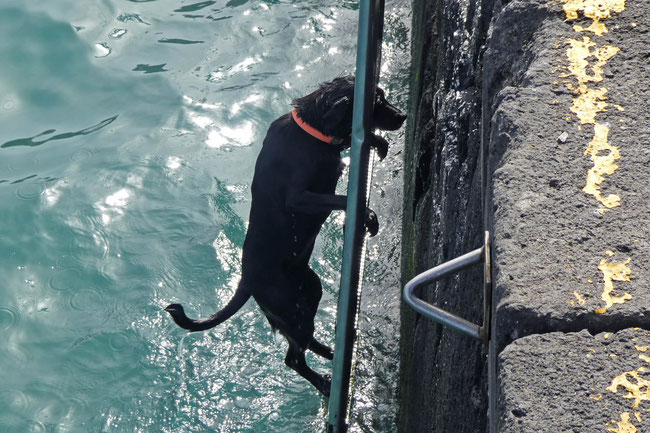
Tenerife, the largest of the Canary Islands, is a major tourist destination for northern Europeans and Spaniards (The Canary Islands are part of Spain).
While most of the tourists head for the south coast, a major secondary concentration is at Puerto de la Cruz, on the north coast.
Tenerife, the largest of the Canary Islands, is a major tourist destination for northern Europeans and Spaniards. (The Canary Islands are part of Spain). While most of the tourists head for the south coast, a major secondary concentration is at Puerto de la Cruz, on the north coast.
Puerto de la Cruz
Puerto de la Cruz is on a wild and rocky piece of coastline. There are long beaches a kilometre or so either side of the town. While these beaches are very popular, they are not like placid Mediterranean beaches; they are on the Atlantic Ocean, so they are exposed to a five-thousand kilometre fetch, and are commonly wild places, beyond of the swimming experience of most European or Mediterranean visitors.
For calm-water swimming the town has several huge swimming pools along the shoreline; but for ocean swimming in calmer sea water within the town there are only a couple of small protected beaches. One of the beaches is Playa del Muelle, which is within the town’s little semi-artificial harbour.
Here’s the sea wall behind the channel through the harbour entrance, keeping out those Atlantic swells:
This is Playa del Muelle:
If, like me, you are used to the soft golden sand of Australian beaches you won’t think much of the look of Playa del Muelle as a place to lay out your towel. But I’ve seen photos of this beach in the summer covered in sunbakers and beach umbrellas. (I’m here in the winter, so it’s quiet now.)
When you consider that the shoreline infrastructure of Puerto de la Cruz was built in the face of continuous Atlantic swells, mostly in the nineteenth and early twentieth centuries, you have to think that the builders did an amazing job. The walls of the harbour entrance had to be built twice, as the first lot were destroyed in a winter storm before they were finished.
This is a beautifully hand-laid sea wall along Calle de San Telmo on the foreshore. You can see the lumps of primordial rock that the wall has been built around coming through it.
The diving dog
While we were visiting the harbour in Puerto de la Cruz we saw a black Labrador jump off the harbour wall to go for a swim around in the harbour.
The jump from the wall was about two-and-a-half metres! Here she is pushing off hard from the harbour wall with her back legs:
Here she is, mid-air, about to hit the water:
Our first thought was “how is she going to get out? Will she eventually swim back to the beach?” No – she climbed up one of the safety ladders on the wall!
While we were at the harbour she performed this routine many times. Eventually her owner told her it was time to go, so she stopped; but he got into a conversation, and after a while she gave up on him and went back to jumping in and climbing out.
Here’s a short video of her in action:
She obviously loves doing this, and, as you can see in the video, she’s a strong swimmer.
Tags
If you enjoyed this blog post, you can find related posts under these headings:
Previous post:
< Previous post
Next post:
future post >
Share this The Journey and the Destination post using your favourite social media:
Would you like to add something, or ask a question? Add a comment below (you can leave the 'Website' field blank):










Chris (The Journey and the Destination) (Friday, 24 April 2020 05:39)
I thought You'd appreciate this one! I was between housesit dogs at the time, having just left a marvellous young black labrador called Alfie in San Pedro de Alcántara in Spain. You get used to have a dog around and that makes you notice them!
Seth has done well to make fifteen; our Prema got to that age.
Elea (Friday, 24 April 2020 04:04)
Remarkable creature!
Sethy is nearly 15 now and finding our stairs a bit difficult!